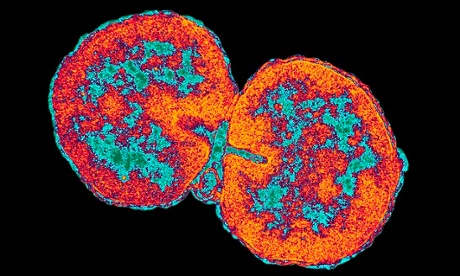
A highly drug-resistant gonorrhoea outbreak in the north of England has triggered an unprecedented national public health alert.
Fifteen cases of “super-gonorrhoea” have been detected by Public Health England since March, the British Association for Sexual Health and HIV reported.
Drug-resistant cases are rare, the body said, with few reports to PHE’s sexually transmitted bacteria reference unit, though the EU’s infectious diseases monitor has been warning about the growing threat of drug-resistant gonorrhoea for some years.
The UK outbreak, first detected in Leeds, has since spread, with cases reported in patients from Macclesfield, Oldham and Scunthorpe. All of the cases involve heterosexual patients, and some people have reported partners from other parts of England.
Gonorrhoea is traditionally treated with azithromycin, a drug that has so far failed to kill this strand of the infection.
Without treatment, the infection can lead to serious long-term health problems, including infertility, or potentially life-threatening pelvic inflammatory disease in women. In pregnant women it can also cause permanent blindness in a newborn.
The association said: “An outbreak control team meeting has been convened and [the bacteria reference unit is] currently performing next-generation sequencing on these strains to better understand the molecular epidemiology.”
It added: “PHE is concerned that the effectiveness of current frontline dual therapy for gonorrhoea will be threatened if this resistant strain continues to spread unchecked.”
News of the British cases comes less than a day after the European Centre for Disease Prevention and Control (ECDC) reported gonorrhoea rates in Europe had gone up by 79% since 2008, particularly among men. The UK reported 61% of all cases in Europe, though Britain is known to do more stringent monitoring.
“The rising rates of gonorrhoea in many countries, although affected by increased testing among at risk groups, indicate ongoing unsafe sexual behaviour,” the centre said in a statement, adding there was a worrying number of antimicrobial-resistant strains.
Earlier research by the ECDC indicated that 5% of all isolates of the bacteria showed resistance to some of the main antibiotics used for treatment of gonorrhoea in Europe. “The loss of [those antibiotics] as treatment options would have a significant impact on public health,” the body’s report said.
“This outbreak is worrying as azithromycin is one part of the recommended European treatment regimen for gonorrhoea, which is a combination of azithromycin and ceftriaxone,” the ECDC’s STI programme head, Andrew Amato-Gauci, told the Guardian.
“There are very limited alternatives to treatment of gonorrhoea once resistance to azithromycin and ceftriaxone become widespread,” he continued. “Senior clinicians, epidemiologists and public health specialists working in the STI field have long advocated for the need to develop new antibiotics to treat gonorrhoea and this outbreak only serves to emphasise this pressing need.”
The number of antibiotic resistant infections detected in Britain as part of this current health warning may seem small, said Peter Greenhouse, a consultant in sexual health based in Bristol, but there could be undetected cases.
PHE told the Guardian it could not speculate on the numbers, but Greenhouse said the national health warning implied many more people were infected.
“This azithromycin highly resistant outbreak is the first one that has triggered a national alert,” he told the BBC.
“It doesn’t sound like an awful lot of people, but the implication is there’s a lot more of this strain out there and we need to stamp it out as quickly as possible. If this becomes the predominant strain in the UK we’re in big trouble, so we have to be really meticulous in making sure each of these individuals has all their contacts traced and treated.”
There were almost 35,000 cases of gonorrhoea reported in England last year. It is the second most common bacterial sexually transmitted infection in the UK after chlamydia, with the bacteria transmitted through discharge from the penis and vagina.
The majority of cases affect people under the age of 25. About 10% of men and almost half of women with the infection do not experience symptoms, those who do may have unpleasant discharge and pain while urinating.

